Design und Betrieb / Design and Operation
ABCs of Mine Run Operations
- Details
- Kategorie: Design und Betrieb
- Zuletzt aktualisiert: Donnerstag, 18. Dezember 2014 21:02
- Geschrieben von Michael Homberg
ABCs of Mine Run Operations
by Dan Bourque
In order to effectively model coal operations on your layout, you first have to understand how a mine run works on the prototype. In this article, I’ve drawn up a make-believe yard and branch line that our mine run (known as a “shifter” on some railroads like the N&W and Clinchfield) has to work. Like tipples, no two mine runs are exactly alike, and each has its own set of operating challenges. Our mine run will take us through several of these challenges and how a crew might handle them.
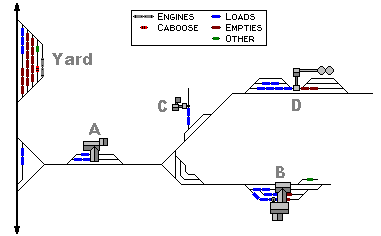
The first thing our mine run does is assemble its train. Upon receiving directions from the dispatcher, the mine run heads out of the yard, down the mainline, and onto the branch line. On the way it passes two loaded hoppers on a siding that could not be brought back to the yard yesterday for some reason.

The first stop is Loader A where the first three empties are set off. On our branch line (as with most), the rails go upgrade from the mainline, so empties are spotted “above” the loader where they can be coasted into loading position as needed. Our train is then reassembled, and we head further up the branch line.

Although many branches are straight lines, many split and fork to serve more mines. This is the case with our branch. There is a tiny yard at our wye, so rather than take extra cars up to the already-crammed Loader B, we’ll set off our empties for Loaders C and D and take only the five empties bound for Loader B. Also, because we may not have an available track to run-around on, we’ll place our covered hopper ahead of the engines. On other branches, the entire train may have to be placed ahead of the engines.
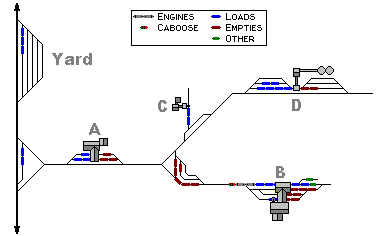
When we arrive at Loader B, we’ll cut off our caboose, take our empties, and shove them into the empty tracks. Next, we’ll take our engines, remove the empty covered hopper waiting in the house track, and set out our loaded covered hopper in its place. Leaving the empty covered hopper on the tail track, we pull all the available loads (6), grab the empty covered hopper, couple to our caboose (now ahead of the engines because we had no place to run-around it) and head back to the wye yard.
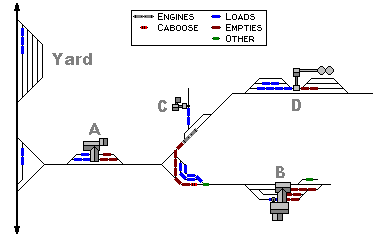
Back at the wye yard, we’ll set off all the loads from B (plus the empty covered hopper) and assemble all the remaining empties and the caboose (now at the end of the train because we were able to run-around it at the wye). Now we head up the second branch towards loaders C and D with our six remaining empties.
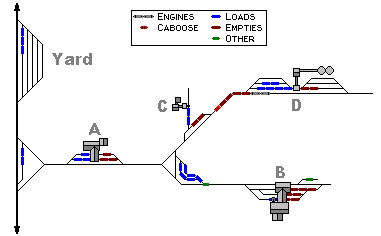
Because the load track at Loader C is a facing-point operation, it will be much easier to work on the return leg, so we just set off its two empties on the siding and continue on to Loader D.
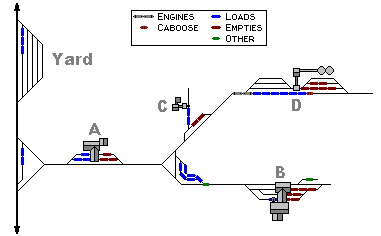
There’s plenty of room at Loader D, so it’s no problem spotting our empties, running around our caboose, pulling our loads, and reassembling our train for the trip back to Loader C.
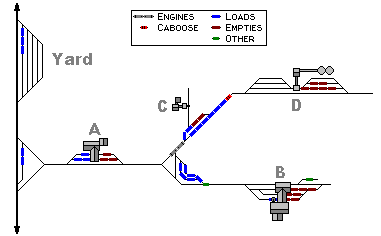
Back at Loader C, we’ll uncouple the engines from the train, back into the siding to pull our two loads, couple onto our two empties, and shove them back under the loader. After reassembling our train, we’re off to the wye yard again.
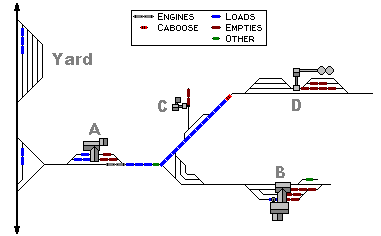
Back at the wye yard, we’ll place all of the loads back onto our train and head back to Loader A. If we have too many loads (i.e. we can’t fit in a required passing siding, we don’t have enough power to pull our loads up a hill, etc.), then we may have to leave a couple of loads at the wye yard for pick up by tomorrow’s mine run.
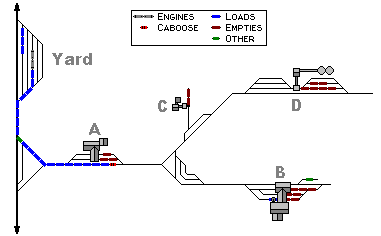
Finally, we’ll run our train to Loader A, cut off the engines, pull the loads from the tipple, couple back onto the train, and head back to the yard. Since our train is below its limit for tonnage and cars, we can go ahead and pick up those two loads on the siding that were left by yesterday’s crew as well.
Once we arrive back in the yard, our mine run’s job is complete. The switching crew will then take our loads, sort them by direction and block them by destination, and move them out on the next coal drag. In the mean time, different trains are delivering empties to the yard for use by the local loaders. All the while, the loaders are working to fill the empties we just provided them so that the whole cycle can begin again tomorrow.
This is a copy with permission (c) 2014 by Dan Bourque, the direct link is this.
On Dan's Website you can find lots of information about Coal Railroading, and Appalachian Railroad Modeling

